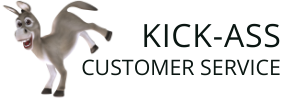Avoid these 3 Costly Customer Service Penalties
Unless you want to “turnover” your customers to the competition, avoid these three common customer service penalties.
It’s Super Bowl time again, and although I’m not a huge fan of professional football (I prefer college and high school football), the annual event nevertheless sparked some thought about penalties – not football penalties, but rather customer service penalties. Indeed, customer service penalties, like football penalties, can prove costly to your business or organization.
So let’s review three of the most common customer service penalties and, even more importantly, let’s explore how your business or organization can avoid or, at the very least, minimize those penalties.
Roughing the Customer: “Roughing the Customer” occurs when we are curt or rude to a customer. A cardinal rule of customer service is to treat customers with professionalism and respect – or, as Lee Cockerell advocates, “Be so nice to the customers that they can’t believe it!” – even if customers are rude or disrespectful to us. Simply put, never lose control with customers.
Use this twofold strategy to avoid “Roughing the Customer”:
- First, if a customer is particularly rude or insulting, remember that there is probably something else happening in the customer’s life, so grant the customer some generous leeway to vent.
- Second, treat the challenge as a game: if the customer later apologizes to you for his or her rude behavior, score yourself a point. Remember, though, that the only way to “win” the challenge is to not lose control with the customer – that is, be sure to keep your emotions and patience “in check.”
Holding:There are three variations of “Holding”:
- First, requiring customers to spend an unreasonable amount of time on hold. As hold time increases, customer frustration grows exponentially, ultimately resulting in customers hanging up and calling your competition.
- Second, requiring customers to enter a long series of numbers on their telephone in order to talk with a customer service representative. Despite the popularity of automated phone trees, customers typically find the technology infuriating, especially if they desire to talk directly with a human.
- Third, abruptly placing customers on hold. When customers are placed on hold in an abrupt manner, they perceive your business or organization as impatient and uncaring.
To avoid “Holding,” ensure that your telephone lines are sufficiently staffed. During particularly busy times, your executive leaders – yes, I’m talking to the directors and managers out there – should help answer telephone calls. If your business or organization uses automated phone tree technology, offer a simple and obvious option for a customer to quickly connect with a customer service representative. Finally, before placing a customer on hold, explain to the customer the reason for placing him or her on hold, and also obtain the customer’s express permission to do so.
Delay of Game: “Delay of Game” occurs when we fail to follow through with, or deliver our products or services to, a customer in a timely manner. “Delay of Game” may originate from a variety of causes, including, for example:
- neglecting to follow through with a customer;
- losing or misplacing a customer’s order or request; or
- failing to sufficiently communicate – or, as Tom Peters says, “over-communicate” – with a customer in regards to the status of his or her order or request.
To avoid “Delay of Game,” ensure that your business or organization has reliable and effective processes in place to minimize the risk of neglected follow through, misplaced customer orders, and delayed communications. Your customer service processes should specifically address common contingencies, including employees who are absent due to illness or vacation, technology glitches and failures, and other vulnerabilities and bottlenecks that could result in customer service delays.
This week, take a moment to accurately assess how frequently your business or organization commits these and other customer service penalties, and then dedicate some time to not only train your team, but also to create or modify your processes, to minimize those penalties.
Mark
